Join Cultural Samvaad’s WhatsApp Community
Mahabalipuram or Mamallapuram is a small town situated on India’s southern coastline in the state of Tamil Nadu. Not far from the state capital, Chennai, the land of the ‘Seven Pagodas’which once a bustling port has withstood probably more than one tsunami to tell its tale. The group of monuments that this 7th century CE Pallava town is most famous for, put Mahabalipuram on the world heritage list when they were inscribed as a UNESCO World Heritage Site in 1984.
UNESCO World
The group of monuments are a living testimony to the vision and architectural prowess of the Pallava rulers and each of them is a masterpiece in itself. For this note however, we will limit the discussion to one of the most famous of these masterpieces, one of Asia’s largest relief sculptures, measuring 30 metres x 15 metres and known variously as ‘Arjuna’s Penance’ and the ‘Descent of the Ganga (Ganges)’.

This east-facing bas relief also commonly referred to as the Mahabalipuram bas relief is probably unparalleled in the whole of Indian sculptural tradition in terms of the sheer breadth of its composition. From epic narratives to Panchatantra and from nagas to elephants and human beings; the sculptors have chiselled innumerable subjects.
The relief is home to more than 100 figures and stretches across two large boulders of granite interrupted by a natural and large perpendicular fissure which could have been the passage for an artificial stream of water.
Shiva and the Tapasvi
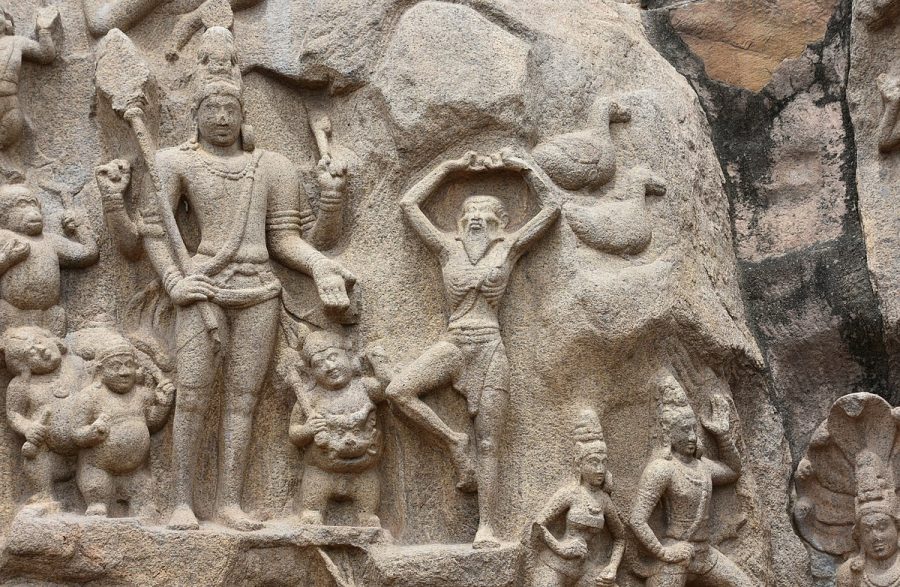
Wikimedia Commons
One of the most striking parts of the great Mahabalipuram relief is that of the four-armed great Lord Shiva and an emaciated man. That the towering god is Mahadeva is well established. He is flanked by his ganas (lieutenants) and one of his hands in the varada mudra (a gesture that denotes that he is giving a boon).
Who is the emaciated man standing on one foot and engrossed in deep meditation (tapasvi)? This question has puzzled many scholars and lay onlookers for centuries and there seems to be no one answer.
Arjuna’s Penance in the Mahabharata and retold in the famous sanskrit mahakavya Kirātārjunīya by Bhāravi
One set of scholars tend to aver that the tapasvi is none other than the third Pandava – Arjuna and the sculptors were depicting an incident in the Vana Parva of the great epic Mahabharata which was later on expanded in the Kirātārjunīya. It is pertinent to note that this mahakavya by Bhāravi was well known in the land of the Pallavas and has been depicted in Kanchipuram.
The story goes thus. Arjuna undertakes severe penance to propitiate Mahadeva – Lord Shiva. Pleased by his austerities, Shiva appears in the form of a kirāta or a mountaineer. Arjuna fails to recognise him and engages in a duel. When he is unable to defeat the great Shiva, he realises his folly and surrenders to the warrior. Shiva rewards him with the Pashupata astra (Shiva’s divine weapon) which plays a critical role during the Mahabharata war.
The Descent of the Ganga
Another set of scholars believe that the tapasvi is Bhagiratha, a famous king of the Ikshavaku dynasty and the relief depicts the famous narrative of the descent of the holy Ganga from the heavens.
The story is told thus. Long long ago, there lived a great king called Bhagiratha, the son of King Dilipa. He was born in the Ikshavaku dynasty in which is also the dynasty in which Shri Rama ( refer the story of Ramayana) took birth later. Bhagiratha realised that many of his ancestors had been burnt to ashes after being cursed by Kapila Rishi (sage). They could only attain moksha (salvation or release) if the holy Ganga descended on the earth and washed away their ashes and sins. Bhagirath undertook severe penance to propitiate Ganga who agreed to come down to the earth. However, she warned that her strong flow would wash away the earth herself. Bhagirath again undertook severe austerities to please Lord Shiva who agreed to hold Ganga in his locks so that only a small portion would flow on earth. Thus, the divine Ganga started flowing on earth and because she came down due to the efforts of Bhagirath, she is also known as Bhagirathi.
Since the debate is still unsettled, the enigmatic relief leaves the reader more than enough room to mull over the stories narrated above as she beholds the boulders in all their magnificence.
The Meditating Cat and the Rats
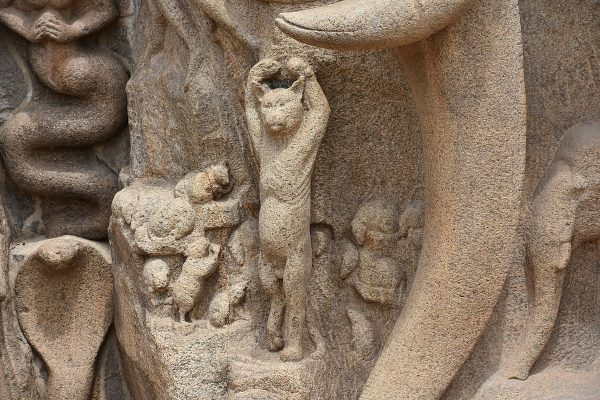
In the lower portion of this gigantic relief, one finds a cat standing on one leg and meditating quite like the tapasvi we have encountered before. The cat is of course surrounded by rats! However, this cat is no saint and according to most scholars refers to a famous tale in the Panchatantra.
The tale is about a hypocritical cat, a partridge and a hare. The cat pretends that she is a saintly and has established a reputation for helping solve quarrels in a just manner. One day a partridge and a hare go to her for help. While she promises to help, the shrewd cat pounces them on the first available opportunity and devours them.
Vasudhaiva Kutumbakam – वसुधैव कुटुम्बकम्
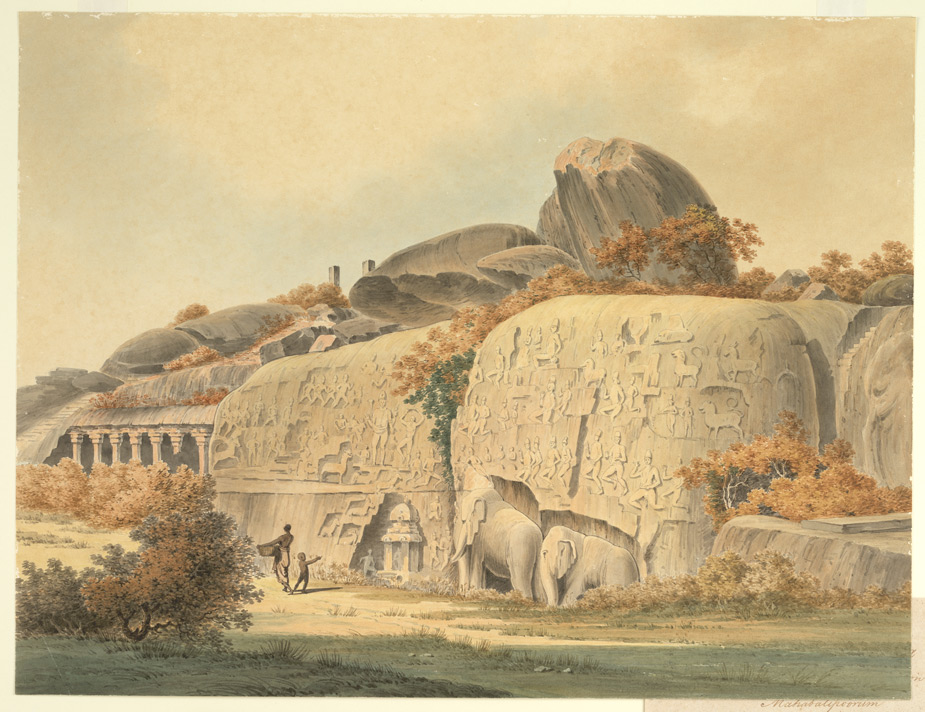
Nineteenth Century CE Painting of the Great Relief at Mahabalipuram
Wikimedia Commons
‘The world or universe is one’. Can a sculpture depict this lofty Indian belief that is a defining feature of Indian culture and tradition? Can a relief sculpted by human hands make the onlooker aware of her deep connections with flora and fauna and all of nature?
It probably can and that is what the Pallava sculptors and their patrons believed.
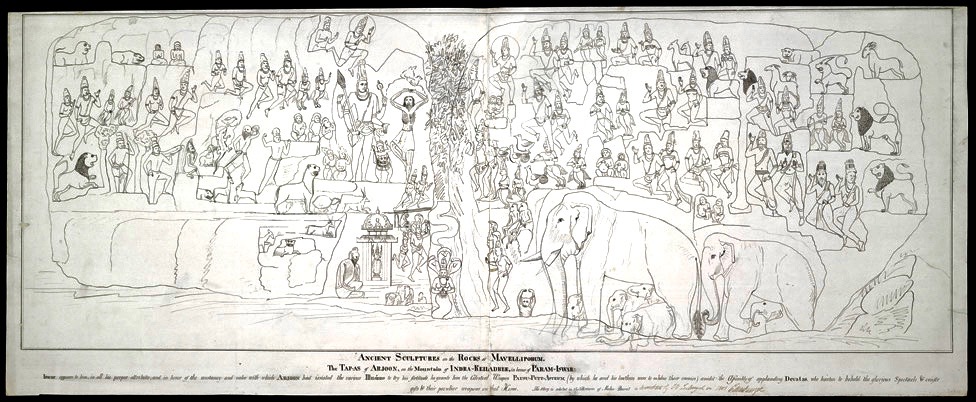
The relief is the controlled chaos that the world reflects at its best. From the herd of gigantic, almost real life-sized elephants with their adorable calves to lions and monkeys and birds and deer, from nagas (depicted as half snakes and half men) to celestial couples (gandharvas) and from a hermitage centred around a temple (frequently interpreted to be the Badrika ashrama in the Himalayas) to visions of beautiful forests, the free-standing, open-air relief is a mirror of our surroundings.
We have but scratched the surface of the great relief at Māmallapuram. It is poetry in stone and has to be seen to be believed. No wonder it is made its way to the original manuscript of the Constitution of India as a painting and is now one of the most visited places in India by tourists and If I could add to your bucket list of places to see in India, the group of monuments at Mahabalipuram would find a place for sure
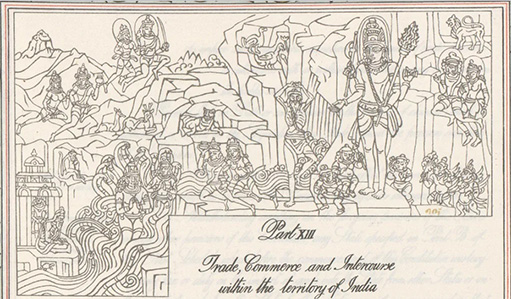
Editor’s Note
This is not meant to be a scholarly exposition on the subject. However, it draws upon the works of many scholars and a list of references has been provided for those who would like to explore more. The group of monuments at Mahabalipuram is managed by the Archaeological Survey of India, Chennai Circle.
*Image Credit: https://commons.wikimedia.org/w/index.php?curid=16036805
References
- Archaeological Survey of India. “Mahabalipuram”, 2006.
- Rabe, Michael D. “The Māmallapuram Praśasti: A Panegyric in Figures.” Artibus Asiae, vol. 57, no. 3/4, 1997.
- Kaimal, Padma. “Playful Ambiguity and Political Authority in the Large Relief at Māmallapuram.” Ars Orientalis, vol. 24, 1994.


Add comment